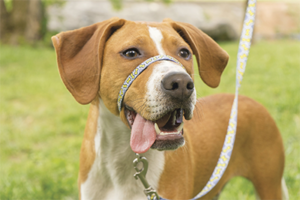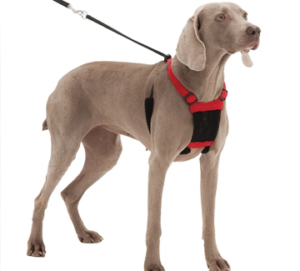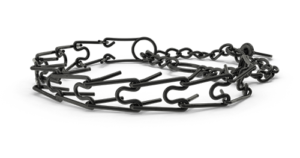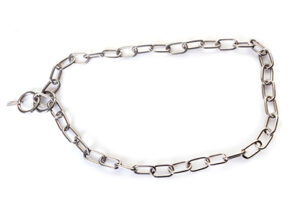Dogs that pull excessively can put their owners at risk of injury, as well as making daily walking a chore and an annoyance. There are several options to help reduce pulling, but there is no “magic” collar/harness to stop the behavior. TRAINING, TRAINING, and more TRAINING combined with a specific collar or harness will give you the best results and make walking your dog a pleasant experience. If your dog is 6 months or older you can train using a corrective collar. Puppies younger than 6 months should only train with a buckle collar. Below are some available training collars/harnesses:
Head/Halter Collars
 This is a true training collar. It works by pressing slightly on the dog’s muzzle and neck. This collar is self-correcting. You never need to pull or yank on it. Instead, the dog will correct itself when it pulls. When the dog tries to pull, he will feel pressure that will push his head down and pull his muzzle to the side. Where the head goes, the body follows. This collar is an excellent training collar in that it does not cause or heighten aggression. These collars do require patience to teach your dog to wear them and be comfortable. There are excellent training instructions included when you purchase these collars. The most well-known brand is Gentle Leader Chic® (this is the doctors’ favorite!) www.petsafe.net. The Gentle Leader website has a demonstration video. Halti® (www.halti.com) and Canny (www.cannyco.us) are other brands. There is also one designed for brachycephalic (“smush-face”) dogs, called the Snoot Loop®
This is a true training collar. It works by pressing slightly on the dog’s muzzle and neck. This collar is self-correcting. You never need to pull or yank on it. Instead, the dog will correct itself when it pulls. When the dog tries to pull, he will feel pressure that will push his head down and pull his muzzle to the side. Where the head goes, the body follows. This collar is an excellent training collar in that it does not cause or heighten aggression. These collars do require patience to teach your dog to wear them and be comfortable. There are excellent training instructions included when you purchase these collars. The most well-known brand is Gentle Leader Chic® (this is the doctors’ favorite!) www.petsafe.net. The Gentle Leader website has a demonstration video. Halti® (www.halti.com) and Canny (www.cannyco.us) are other brands. There is also one designed for brachycephalic (“smush-face”) dogs, called the Snoot Loop®
Harnesses
 A “regular” harness is designed to allow, and even encourage, a dog to pull and to prevent damage to the neck. However, there are now several “anti-pull” harnesses on the market. There are several different designs, which discourage pulling via different methods. The Gentle Leader Easy Walk® harness places the leash across the front (pectorals) of the dog and squeezes the shoulders when the dog pulls forward. The Sporn® harness (www.sporn.com) causes discomfort by pulling/squeezing in the “armpits” of the dog when the dog pulls forward. These harnesses do not always work well for very exuberant dogs, but are a nice option. These do not cause or heighten aggression and are an option for dogs who cannot wear collars.
A “regular” harness is designed to allow, and even encourage, a dog to pull and to prevent damage to the neck. However, there are now several “anti-pull” harnesses on the market. There are several different designs, which discourage pulling via different methods. The Gentle Leader Easy Walk® harness places the leash across the front (pectorals) of the dog and squeezes the shoulders when the dog pulls forward. The Sporn® harness (www.sporn.com) causes discomfort by pulling/squeezing in the “armpits” of the dog when the dog pulls forward. These harnesses do not always work well for very exuberant dogs, but are a nice option. These do not cause or heighten aggression and are an option for dogs who cannot wear collars.
Prong Collars
 Prong collars are used to provide correction for the “wrong or bad” behavior. They work by pinching the skin when the dog pulls. Although this is less traumatic to deeper structures than a slip chain, it does correct by discomfort. They should be loose except when performing an actual correction. If a dog is pulling despite wearing a prong collar, then the collar is not being used correctly. These collars should only be used under the supervision of a trainer and should never be left on the dog. In some dogs, correction using a prong collar can increase aggression. Also, using a prong incorrectly or harshly can cause wounds to the neck as well as damage your emotional bond with your dog. Finally, this collar should never be pulled over the head—instead the links are made to disconnect so the collar “falls off” the neck.
Prong collars are used to provide correction for the “wrong or bad” behavior. They work by pinching the skin when the dog pulls. Although this is less traumatic to deeper structures than a slip chain, it does correct by discomfort. They should be loose except when performing an actual correction. If a dog is pulling despite wearing a prong collar, then the collar is not being used correctly. These collars should only be used under the supervision of a trainer and should never be left on the dog. In some dogs, correction using a prong collar can increase aggression. Also, using a prong incorrectly or harshly can cause wounds to the neck as well as damage your emotional bond with your dog. Finally, this collar should never be pulled over the head—instead the links are made to disconnect so the collar “falls off” the neck.
Slip-chain (Choke) Collars
 Slip-chain collars, or choke chains, are one of the oldest training collars. These collars require excellent training skills to use correctly. The collar sits high on the neck and corrects the dog with a fast tug and release method. It is important the collar be fitted correctly—if it is too long or too short it will not work. A dog that continues to pull while wearing this collar is at risk of choking and damaging his neck. If a dog is pulling despite wearing a choke collar, then the collar is not being used correctly. This collar should only be used under the supervision of a trainer and should never be left on the dog. There are so many other easier/better options available that we do not recommend this collar.
Slip-chain collars, or choke chains, are one of the oldest training collars. These collars require excellent training skills to use correctly. The collar sits high on the neck and corrects the dog with a fast tug and release method. It is important the collar be fitted correctly—if it is too long or too short it will not work. A dog that continues to pull while wearing this collar is at risk of choking and damaging his neck. If a dog is pulling despite wearing a choke collar, then the collar is not being used correctly. This collar should only be used under the supervision of a trainer and should never be left on the dog. There are so many other easier/better options available that we do not recommend this collar.
What's Next
Call us or schedule an appointment online.
Meet with a doctor for an initial exam.
Put a plan together for your pet.

